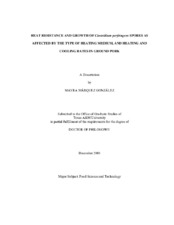| dc.description.abstract | The survival and germination of Clostridium perfringens spores in different
heating media and at different heating rates was studied to determine the fate of C.
perfringens spores during abusive cooking and cooling of pork products. The heat
resistance (HR) of C. perfringens spores from three strains that were either previously
heat shocked (HS) or non-heat shocked (NHS) was determined individually and as a
cocktail in phosphate buffer solution (pH 7.4) (PBS), beef gravy (BG), ground pork (GP)
and cured ground pork (CGP) at 75ºC. The effect of the heating rate on HR, germination
and outgrowth of C. perfringens spores in CGP was determined by increasing the
temperature from 20 to 75ºC at a rate of 4, 8, and 12ºC/h prior to heating and holding at
75ºC for 48 h. Heating rates at 4ºC/h in GP and CGP were repeated with additional
cooling from 54.4 to 7.2ºC within 20 h (temperature abuse).
Linear survival curves were observed on NHS spores in the four heating media,
whereas HS spores showed linear curves when heated in PBS and BG, and biphasic
curves when heated in GP and CGP. In general, HS spores were more heat sensitive than NHS spores. NHS spores heated in GP had greater HR than spores heated in CGP, BG
or PBS.
There were no significant differences (P>0.05) on the HR of C. perfringens
spores in CGP heated from 20 to 75ºC at 4, 8, or 12ºC/h. Heating rates of 8 and 12ºC/h
showed no difference in germination and outgrowth of inoculated spores, whereas at
4ºC/h, growth of C. perfringens occurred between 44 and 56ºC.
Temperature abuse during cooling of GP resulted in 2.8 log CFU/g increase of C.
perfringens counts. In CGP, C. perfringens counts decreased by 1.1 log CFU/g during
cooling from 54.4 to 36.3ºC and then increased by 1 log CFU/g until the product reached
7.2ºC. However, with an initial inoculum in raw CGP of 5 log CFU C. perfringens
spores/g, C. perfringens counts did not exceed 3.4 log CFU/g during a 20 h abusive
cooling. These results suggest there is no risk associated with C. perfringens in cured
pork products under the conditions tested. Results from the present study indicate that
different behavior may be expected with different meat products. | en |


